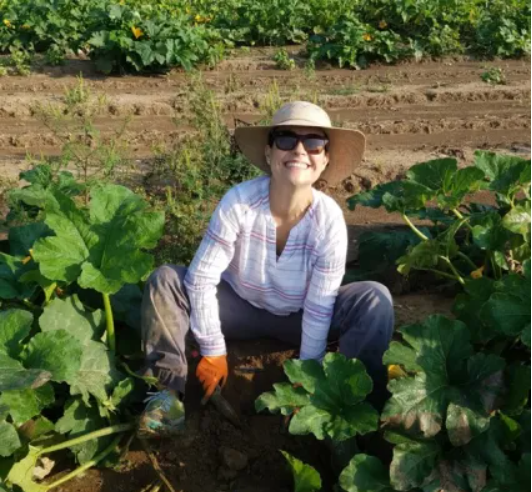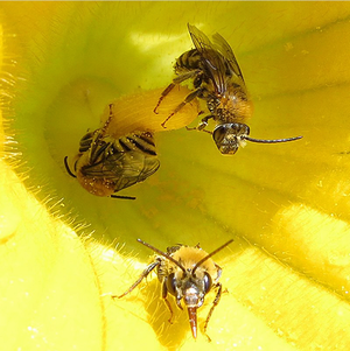
UNIVERSITY PARK, Pennsylvania, April 4, 2023 (ENS) – Numbers of bees and other pollinator species have declined worldwide, as these insects suffer due to pesticides and pathogens, likely amplified by climate change. Yet one bee species is showing rapid population expansion. The keys to this insect’s success are its attraction to pumpkins, zucchinis, marrows and gourds, and the massive increase in cultivation of these crops across North America over the last 1,000 years.
A new study, led by scientists at Pennsylvania State University and published April 3 in the journal “Proceedings of the National Academy of Sciences,” found that the specialized squash bee, Eucera pruinosa, has evolved in response to intensifying cultivation of squashes in the genus Curcurbita. Many different cucurbits are consumed around the world, and the majority of the plants are medicinally valuable.
“When we think of insects benefiting from and adapting to widespread agriculture, we tend to think of pests such as certain kinds of moths, flies and beetles,” said Margarita López-Uribe, associate professor of entomology at Penn State. “But the impact of agricultural intensification on the evolution of beneficial pollinators is poorly understood. We found that agriculture facilitated increases in population size of this squash bee, and this may be the case for other insect pollinators, as well.”

The research is the first to demonstrate the role of agriculture as an evolutionary force acting on a wild insect pollinator and may have implications for food security.
López-Uribe said that the study is the first to identify adaptive processes of an insect pollinator in response to human agricultural practices. This study demonstrates that human agriculture in North America has had a profound impact on the evolutionary history of an insect that is an essential pollinator of squash crops, she said.
Longhorn bees, Eucerini, are a diverse group of large bees that includes pollinators of both wild and agricultural plants. The name comes from the long antenna found on males of many of the species. Longhorn bees are found across much of world. They are solitary bees, each female makes her own nest in the ground.
“Pollination is such an important process that impacts so much of the food we eat. Understanding how humans have and continue to impact that process and pollinators – through agriculture, urbanization and in other ways – is key to ensuring we maintain food security,” said Sam Scheiner, program director at the U.S. National Science Foundation, which partially funded the work.
“This research highlights how domesticating plants can have important indirect effects on the organisms that pollinate those plants,” he said.
Squash bees are found only in the Americas and the greatest number of species is in Mexico. Historically, the squash bee’s primary source of pollen was the wild buffalo gourd, Curcurbita foetidissima, a baseball-sized squash that grew in the deserts of Mexico and the southwestern United States.
As one of the “Three Sisters,” which includes corn and beans, squash was an important crop of Indigenous Peoples in the Americas, and around 5,000 years ago, Indigenous Peoples of the Eastern Woodlands began to domesticate a relative of C. foetidissima, called C. pepo.

Widespread cultivation of the resulting crops – which included pumpkins, squash, and gourds – began later, around 3,000 years ago, and was intensified around 1,000 years ago with the introduction of corn, also called maize, to the agricultural systems of North America.
“By planting squash all over North America, humans created habitat for the squash bee, and that allowed its population to explode,” said López-Uribe. “Today, the squash bee occurs throughout the United States and southeastern Canada – far beyond the range of its original food source.”
To investigate the evolution of the squash bee in response to the intensification of Curcurbita agriculture, the team sequenced the bee’s genome, examined its genetic structure – the amount and distribution of genetic diversity within and among the bee’s various populations – and searched for signatures of adaptation.
Decreases in genetic diversity, explained López-Uribe, can indicate “selective sweeps,” the process by which new beneficial mutations increase in frequency and become fixed.
Next, the team developed a novel algorithm to estimate the bee’s migration and breeding population size.
The researchers found that the bee’s transition from wild host plants in deserts to temperate agricultural habitats was associated with selective sweeps resulting in substantial reductions in genetic diversity in some parts of the genome.
“Nearly 20 percent of the bee’s genome appears to be linked to these sweeps,” said López-Uribe.
Particularly linked to these selective sweeps were changes in genes associated with chemosensation – the translation of chemical signals from the environment to neurological signals that can be interpreted by an organism. In the case of the squash bee, chemosensation refers to its ability to interpret odor compounds produced by flowers.
“Domesticated Curcurbita plants produce floral blends that are simpler than those of the wild Curcurbita plant,” said López-Uribe. “It is likely that E. pruinosa adapted to a new sensory environment in agricultural habitats, which enabled it to expand its range and significantly increase its population size.”
Other authors on the paper include Nathaniel Pope, postdoctoral scholar, University of Oregon; Avehi Singh, graduate student in ecology, Penn State; Karen Kapheim, associate professor of biology, Utah State University; and Anna Childers, computational biologist, and Jay Evans, research entomologist, Bee Research Laboratory, U.S. Department of Agriculture, USDA.
This research was supported by the U.S. National Science Foundation, the USDA National Institute of Food and Agriculture, the USDA’s Agricultural Research Service, and Dovetail Genomics.
Featured image: Kirby Smith, field representative for Congressman Frank Lucas, picks squash for Farm to Food Bank project. Leedey, Oklahoma. (Photo courtesy Oklahoma Association of Conservation Districts)
© 2023, Environment News Service. All rights reserved. Content may be quoted only with proper attribution and a direct link to the original article. Full reproduction is prohibited.

